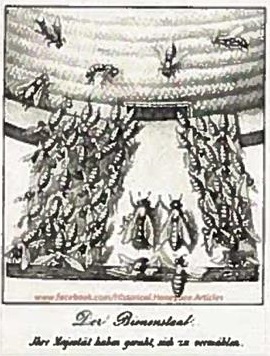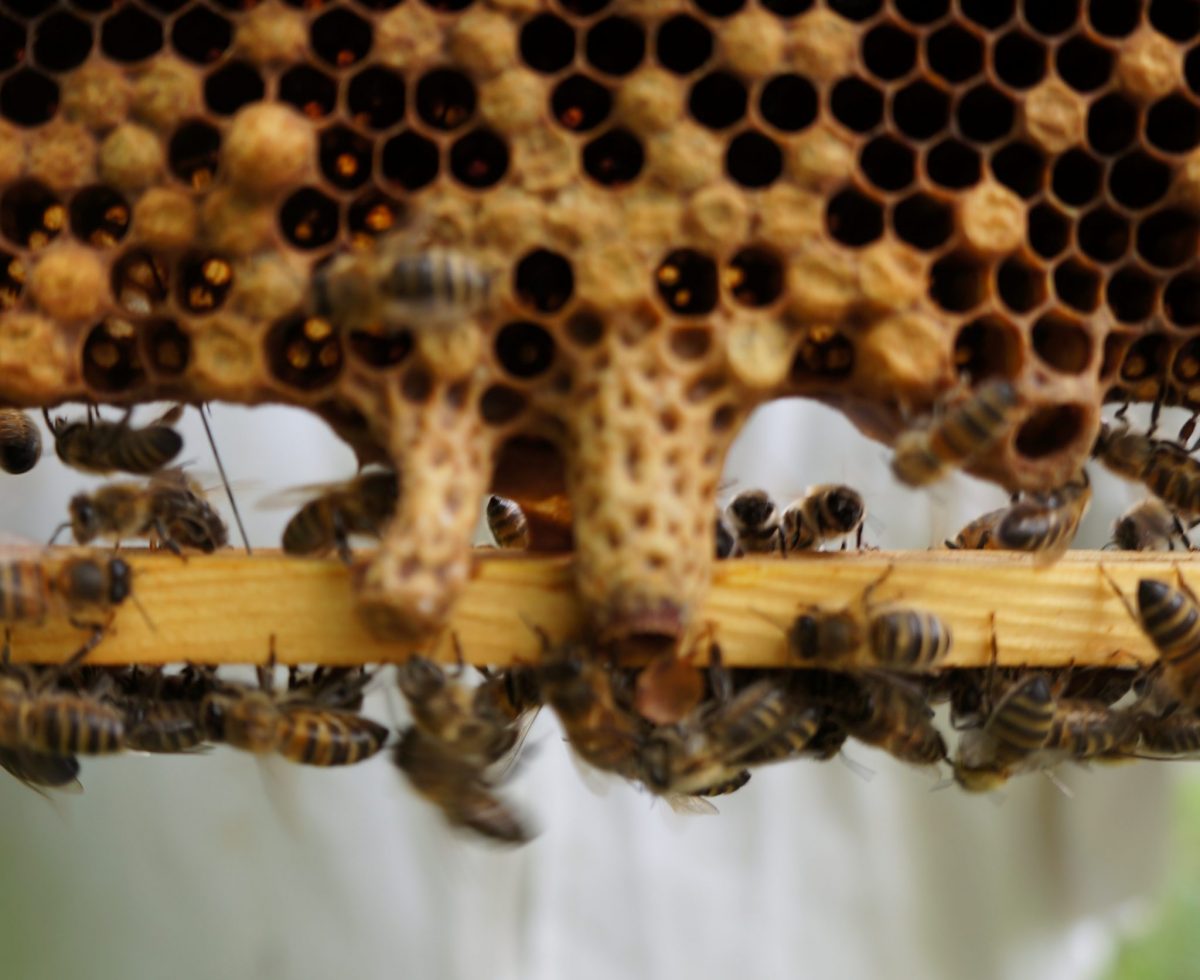 Abraham Lincoln
If given the truth, the people can be depended upon to meet any national crisis...
Abraham Lincoln
If given the truth, the people can be depended upon to meet any national crisis...
 Guildford news...
for Guildford people, brought to you by Guildford reporters - Guildford's own news service
Guildford news...
for Guildford people, brought to you by Guildford reporters - Guildford's own news service
Beekeeper’s Notes May 2018: ‘Long Live The Queen’ But She Has To Go
Published on: 1 May, 2018
Updated on: 29 Apr, 2018
Hugh Coakley keeps bees in Worplesdon. He queries his bees political leanings; when they depose the queen, are they republicans or carrying out a palace coup? And what to do with a much misunderstood queen.
In between the weeks and weeks of cold and rain in April, I did have some chance to get into the hives to assess my plans for the coming season.

‘Her Majesty has leisurley decided to multiply’. A print from 1851 charmingly showing the queen as being in complete control, even choosing when and with whom to mate.
A beekeeper’s plans very often centre on what to do about the queen.
Over the years, the different roles of the queen and her subjects were not well understood. It wasn’t until the 1700s when the microscope enabled us for the first time to establish that the queen was in fact female.
Various myths held sway such as bees coming from the rotting corpses of oxen. Another misunderstanding was to assume that the workers laid the eggs, not the queen.
The busy beehive was seen to be a fine example of society with the monarch – like medieval times – to be very much in control of the hive. The common bees, like the serfs and freemen, were assumed to know their place and do what they were told.
When you see the queen processing around the hive, looking magnificent and majestic against the lowly workers and the burly drones, you can see why.
But is it true?
Well, she does get the right royal treatment right from the start, being fed with extra royal jelly to elevate her up from an ordinary worker bee.
And of course, she can’t look after herself so she is fed and watered throughout her life by her attendants.
So, is she in total charge and dominating her people, like a medieval ruler? Well, I’m not so sure.
She does play a central role in the hive and her charms (or pheromones) keep the colony together but it is the colony, not her, that decides when she has to go.
She is special and important but she is very much at the mercy of the colony. The colony, when they build queen cells and nurture new virgin queens, seems to decide if she is to be deposed.

Queen cell built by the workers when they need a new queen. You can see the open flap at the bottom where the queen emerges.
But when they do get rid of her, it’s not a republican revolt because the hive always end up with a queen.
It could be a palace coup d’état with plotting coutiers setting one of the queen’s own daughters on the throne – manoeuvring to control her after the mother’s death.
Or, being practical, I’m sure it is nothing like a miniature human state at all. It is just insects doing what they have to do to survive and doing it very well over the last 20 million years.
However, away from the musings and back to my bees.
A well supported view in current beekeeping is that you need young queens, ideally no older than a couple of years. The thinking is that young queens are more prolific; lots of brood equal lots of workers and a strong, healthy, productive hive.
Another reason is that younger queens are less likely to swarm. Swarms are not generally desirable from the beekeepers point of view. Apart from worrying your neighbours, you lose half your bees.
So, palace coup or bloody revolution, for the sake of the nation, she has got to go.
Recent Articles
- Guildford Institute’s Crowdfunding Project for Accessible Toilet in its New Community and Wellbeing Centre
- Letter: Guildford – Another Opportunity Missed?
- Letter: GBC’s Corporate Strategy – Where Is the Ambition?
- My Memories of John Mayall at a Ground-breaking Gig in Guildford Nearly Six Decades Ago
- Westborough HMO Plans ‘Losing the Heart of the Street’ Says Resident
- College Invests to Boost Surrey’s Economy and Close Digital Skills Gap
- Community Lottery Brings Big Wins for Local Charities
- GBC Housing Plan Promises ‘A Vibrant Urban Neighbourhood’ Near Town Centre
- Hospital Pillows ‘Shortage’ at the Royal Surrey
- Updated: Caravans Set Up Camp at Ash Manor School


Search in Site
Media Gallery
Dragon Interview: Local Artist Leaves Her Mark At One of England’s Most Historic Buildings
January 21, 2023 / No Comment / Read MoreDragon Interview: Lib Dem Planning Chair: ‘Current Policy Doesn’t Work for Local People’
January 19, 2023 / No Comment / Read MoreA3 Tunnel in Guildford ‘Necessary’ for New Homes, Says Guildford’s MP
January 10, 2023 / No Comment / Read More‘Madness’ for London Road Scheme to Go Ahead Against ‘Huge Opposition’, Says SCC Leader
January 6, 2023 / No Comment / Read MoreCouncillor’s Son Starts Campaign for More Consultation on North Street Plan
December 30, 2022 / No Comment / Read MoreCounty Council Climbs Down Over London Road Works – Further ‘Engagement’ Period Announced
December 14, 2022 / No Comment / Read MoreDragon Interview: GBC Reaction to the Government’s Expected Decision to Relax Housing Targets
December 7, 2022 / No Comment / Read MoreHow Can Our Town Centre Businesses Recover? Watch the Shop Front Debate
May 18, 2020 / No Comment / Read More










Recent Comments